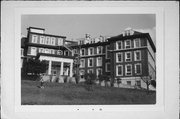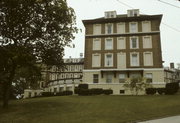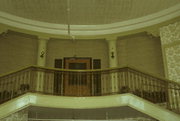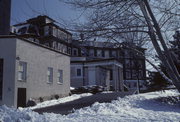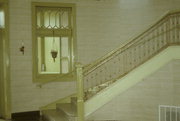Property Record
915 N HARTWELL AVE
Architecture and History Inventory
| Historic Name: | Resthaven Hotel (Sanitarium) |
|---|---|
| Other Name: | NEW TRIBES BIBLE INSTITUTE |
| Contributing: | |
| Reference Number: | 16807 |
| Location (Address): | 915 N HARTWELL AVE |
|---|---|
| County: | Waukesha |
| City: | Waukesha |
| Township/Village: | |
| Unincorporated Community: | |
| Town: | |
| Range: | |
| Direction: | |
| Section: | |
| Quarter Section: | |
| Quarter/Quarter Section: |
| Year Built: | 1905 |
|---|---|
| Additions: | |
| Survey Date: | 1980 |
| Historic Use: | live-in care facility/sanitarium |
| Architectural Style: | Neoclassical/Beaux Arts |
| Structural System: | |
| Wall Material: | Brick |
| Architect: | Koch, Armand |
| Other Buildings On Site: | |
| Demolished?: | No |
| Demolished Date: |
| National/State Register Listing Name: | Resthaven Hotel |
|---|---|
| National Register Listing Date: | 10/28/1983 |
| State Register Listing Date: | 1/1/1989 |
| National Register Multiple Property Name: | Multiple Resources of Waukesha |
| Additional Information: | Architectural Statement: The Resthaven Hotel is a large Y shaped building detailed with classical motifs. Three wings of red brick radiate from a central rotunda with a porticoed entry. The building is veneered with brick and stands three stories above a raised basement. A hip roof rises above the third story and is punctuated by a series of hip roofed dormers. It is considered to be the grandest remaining resort structure in Waukesha. The building was constructed by John H. Foster & Sons in 1905 and is in good condition. It was owned in 1982 by New Tribes Mission, Inc. The primary entrance to Resthaven is through a portico composed of four columns. The lobby area is circular with staircases sweeping down on either side. Simple columns with marble shafts remain as vestiges of the original grandeur of the hotel. The majority of the interior has been remodeled. Another map code is City Map #121. Architectural Significance: Resthaven is a large scale structure, sited on the crest of perhaps the most prominent hill in Waukehsa. The scale and siting contribute to the building's significance as a visual landmark in the community. In addition to its importance as a visual landmark, the design of Resthaven reflects a classical influence, well suited to the monumental scale of the building. Apparently the Classical Revival style was employed for a number of the large sanitariums erected in Waukesha in the early twentieth century ( Waukesha Springs Sanitarium-razed; Grand View Health Resort - 500 Riverview Avenue, WK 43/9). Resthaven is a significant example of this period of construction, and retains a greater amount of integrity than Grandview Health Resort, the only comperable structure. In addition to the original hotel, a one-story outbuilding made of corrugated metal is attached to the east side of the building. Three small, one-story detached buildings lie to the east of the main hotel. And a large metal-sided butler-type building lies directly north of the hotel. None of these buildings contributes to the significance of the nominated property. Historical Statement: Resthaven is significant as the last of the large resort hotels built in Waukesha during its Spring Era. Its period of significance was 1905 to 1919. The concept behind the development of Resthaven was that it would be a place for the overworked to restore their health. It was a hotel but had many of the characteristics of a private club and a health sanitarium. Its investors included included several business leaders from Waukesha, Milwuakee and Chicago. For example, Waukesha investors included Henry Blair, Dr. Wilbur O. Carrier of Carroll College and Andrew I. Frame. Those from Milwaukee included Frederick Pabst and Charles Pfister. [B]. The hotel offered a full range of recuperative and theraputic activities including curative baths, a swimming pool, gymasium and solarium. Golf, tennis and lawn games were also available. The furnishings were plush throughout and it was seen, at the time, as the logical hotel to replace the Fountain Spring House which closed the year Resthaven was built. [A, B]. Unfortunately, Resthaven was built too late to be successful. The Springs Era was dying and the wealthy visitors stopped coming in large numbers. Resthaven began to have financial trouble from the beginning. After only ten years, the owners tried to sell the hotel but were unable to do so. In 1919, the hotel was sold to the Veteran's Administration as a recuperative hospital and later a tuberculosis hospital. The hospital was closed in 1958. After several years of vacancy, the building became the home of the New Tribes Bible Institute, an organization which remains here at present. [A]. |
|---|---|
| Bibliographic References: | A. Koenig, G. H. "The Times Killer Resthaven Hotel", Waukesha Freeman, 9/26/80. B. HOTCHKISS, P. 152 (FOR DESIGNER). C. ZIMMERMANN, #739. Waukesha Freeman 5/9/2003. |
| Wisconsin Architecture and History Inventory, State Historic Preservation Office, Wisconsin Historical Society, Madison, Wisconsin |

